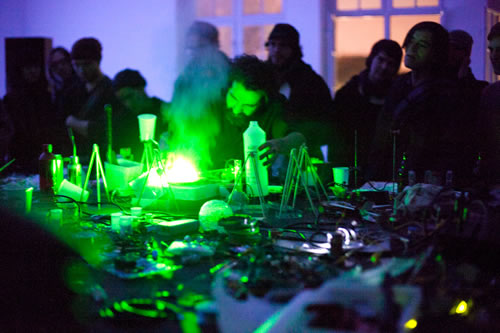Thomas Patteson: Instruments for New Music: Sound, Technology, and Modernism (2015)
Filed under book | Tags: · electric music, machine, media, media technology, modernism, music, music history, musical instruments, radio, sound, sound recording, technology, weimar republic

“Player pianos, radio-electric circuits, gramophone records, and optical sound film—these were the cutting-edge acoustic technologies of the early twentieth century, and for many musicians and artists of the time, these devices were also the implements of a musical revolution. Instruments for New Music traces a diffuse network of cultural agents who shared the belief that a truly modern music could be attained only through a radical challenge to the technological foundations of the art. Centered in Germany during the 1920s and 1930s, the movement to create new instruments encompassed a broad spectrum of experiments, from the exploration of microtonal tunings and exotic tone colors to the ability to compose directly for automatic musical machines. This movement comprised composers, inventors, and visual artists, including Paul Hindemith, Ernst Toch, Jörg Mager, Friedrich Trautwein, László Moholy-Nagy, Walter Ruttmann, and Oskar Fischinger. Patteson’s fascinating study combines an artifact-oriented history of new music in the early twentieth century with an astute revisiting of still-relevant debates about the relationship between technology and the arts.”
Publisher University of California Press, Nov 2015
Creative Commons Attribution Noncommercial ShareAlike 4.0 license.
ISBN 9780520963122 (EPUB), 9780520963122 (PDF)
250 pages
Bernhard Leitner: P.U.L.S.E.: Spaces in Time / Räume der Zeit (2008) [English/German]
Filed under book | Tags: · architecture, art, installation art, sculpture, sound, sound art, space

Bernhard Leitner (*1938) is an artist widely known for his sound sculptures and sound installations. P.U.L.S.E. documents a range of his works made between 1999 and 2008.
“Sound spaces are not simply spaces in which sounds can be heard, but rather, where sounds first create the space, shaping its special characteristics. Audio events can create not only a special experience of the external, surrounding space, they can also make it possible to experience physical space as ‘internal’ space. Leitner’s work leads to acoustic qualities (of space) that remain hidden in the stream of stimuli, and it shows us opportunities for sensuous experience that we are barely aware of, since they have been lost or because their potential has remained unrecognized.” (Cathrin Pichler)
Texts by Boris Groys, Detlef B. Linke, Peter Weibel, conversation with the artist by Stefan Fricke.
Publisher Hatje Cantz, Ostfildern, 2008
A ZKM Book
ISBN 9783775720472
208 pages
PDF (from the author)
Comment (0)eContact! 16(4): Experimental Practices and Subversion in Sound (2015)
Filed under journal | Tags: · experimental music, music, noise, sculpture, sound, sound art, subversion, turntablism

“The ephemeral and varied character of subversion in musical creation makes it a challenging, complex concept to clearly define and illustrate. In this issue it is approached and reflected upon via a range of experimental practices with turntables, tapes and other devices, fringe genres, sound sculptures, and alternative models of music distribution.”
Texts by Karin Weissenbrunner, Stephen Graham, John Oswald, Gary Schultz, dieb13, Antony Maubert, Jon Panther, jef chippewa, JD Zazie; interviews with Joke Lanz, Gheorghe Costinescu, Andrés Lewin-Richter; works by Graham Dunning, Martin Howse, Timo Kahlen.
Guest editor: Karin Weissenbrunner
Publisher Canadian Electroacoustic Community, Montreal, Mar 2015

